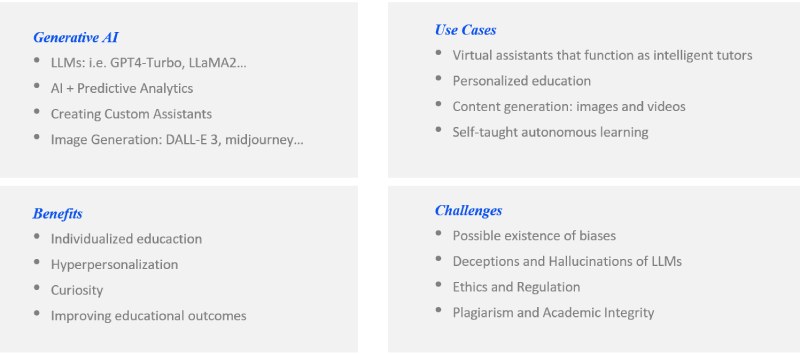The rise of AI in education: How is it transforming the way we learn?
The emergence of generative Artificial Intelligence (GAI) has come to play a significant role in revolutionizing education today. Models such as LLaMA2, GPT4-Turbo and Dall-E 3 are redefining the possibilities of teaching and learning, taking educational potential to new levels and introducing into our vocabulary a new concept that we are sure to talk about a lot, EdTech.
Generative AI has emerged as a valuable tool in education, providing innovative opportunities to improve the way students learn and educators teach. In this sense, the latter will be able to offer personalized learning experiences that adapt to the needs of each student in an individualized way, without having to worry about routine tasks that can be automated.
Likewise, the emergence of AI-powered virtual assistants such as ChatGPT, Copilot, or WatsonX reinforce personalized educational experiences by offering students the possibility of receiving instant answers at any time, feedback or even the resolution of doubts, thus becoming a kind of tutor or personalized guide for students to improve their performance.

New paths are opening up at all levels of education:
- Transforming schools and universities
- Creating impact in corporate training.
- Transforming and fostering autonomous learning.
In schools and universities, in addition to offering individualized education through hyper-personalization and intelligent assistants, we will be able to address major problems that our education system is facing today such as dropouts and outdated curricula.
AI-driven predictive analytics can be used to try to prevent or solve these problems, either by allowing us to identify early on students at risk of dropping out and thus re-evaluate their needs and increase the retention rate, or by creating personalized curricula with an individualized learning style and based on specific academic goals.
At the corporate level, Generative AI is redefining learning roadmaps by adapting them to the role, skills and learning style of each employee. In addition, this technology gives us the ability to evaluate employee performance and adjust training modules on an ongoing basis, thus ensuring that we get the best possible performance out of them.
On the other hand, in terms of autonomous learning, the recent release of GPT4-Turbo has marked a turning point, especially in the area of language learning. This version includes speech capabilities and has become the perfect tool for those who, for example, want to learn a new language or perfect another one in a self-taught way.
✅ The revolutionary thing about GPT4-Turbo is the opportunity it gives us to create customized assistants that are specifically tailored to the specific needs and objectives of each user, offering an interactive and personalized learning experience.
Challenges in the implementation of Generative AI in the educational environment
However, despite its benefits, generative AI faces major challenges. Among them are data privacy, the possible existence of biases in the models, accessibility, as well as the limitations and ethical issues related to the use of content generated by generative AI and the impact that all this can mean on the development of skills such as critical thinking in students. We will discuss some of these below:
- Data privacy: the increasing use of AI in education brings with it an increase in data collection and use. This raises concerns regarding invasion of student privacy that could be addressed by implementing data protection and privacy policies as well as other security techniques.
- Limitations of AI in education: AI lacks the ability for self-correction and nuanced understanding of exercises. This can lead to inaccurate assessments of students. To improve this point, feedback mechanisms could be incorporated into AI models (Reinforcement Learning from Human Feedback) and encourage educator collaboration in order to better understand student needs and the educational context.
- Existence of biases in AI models: AI models in education may use biased datasets, accentuating inequalities. Therefore, it is very important to encourage the use of models that use curated datasets, thus avoiding the reliance of AI on biased datasets that may further disadvantage minority groups.
- Accessibility and equity: the ability to implement AI-based learning will depend on the resources, funding and accessibility of each educational institution which could increase the digital divide between students from different backgrounds. This could be addressed with state grant programs aimed at making AI more accessible or developing simplified versions of some AI models that require fewer computational resources for those educational settings with fewer resources.
- Regulation and ethics of AI in education: it is important to establish clear and effective regulatory frameworks regarding the use of AI in education. These frameworks should address key issues such as privacy of student data, equity in access to the technology, and prevention of bias in algorithms. The involvement of educators, technology experts and regulators will be key to promoting the ethical and responsible use of AI.
AI will be a complement in education and we must train both educators and students with the necessary skills to work with Generative AI technologies and know their limitations.

All this will undoubtedly mean a paradigm shift from a one-size-fits-all educational model to individualized education.
The emergence of generative AI in the educational sector should be understood as a step forward in our way of understanding and transmitting learning.
As Socrates said, "Education is the lighting of a flame, not the filling of a vessel," and it is precisely this spark of curiosity and critical thinking that generative AI seeks to ignite in every classroom.
By evolving and growing with this technology, we will open the doors to a future where education will not only be more personalized, but also more inspiring and able to adapt to the challenges of an ever-changing world.
References:
 Hybrid Cloud
Hybrid Cloud Cyber Security & NaaS
Cyber Security & NaaS AI & Data
AI & Data IoT & Connectivity
IoT & Connectivity Business Applications
Business Applications Intelligent Workplace
Intelligent Workplace Consulting & Professional Services
Consulting & Professional Services Small Medium Enterprise
Small Medium Enterprise Health and Social Care
Health and Social Care Industry
Industry Retail
Retail Tourism and Leisure
Tourism and Leisure Transport & Logistics
Transport & Logistics Energy & Utilities
Energy & Utilities Banking and Finance
Banking and Finance Sports
Sports Smart Cities
Smart Cities





